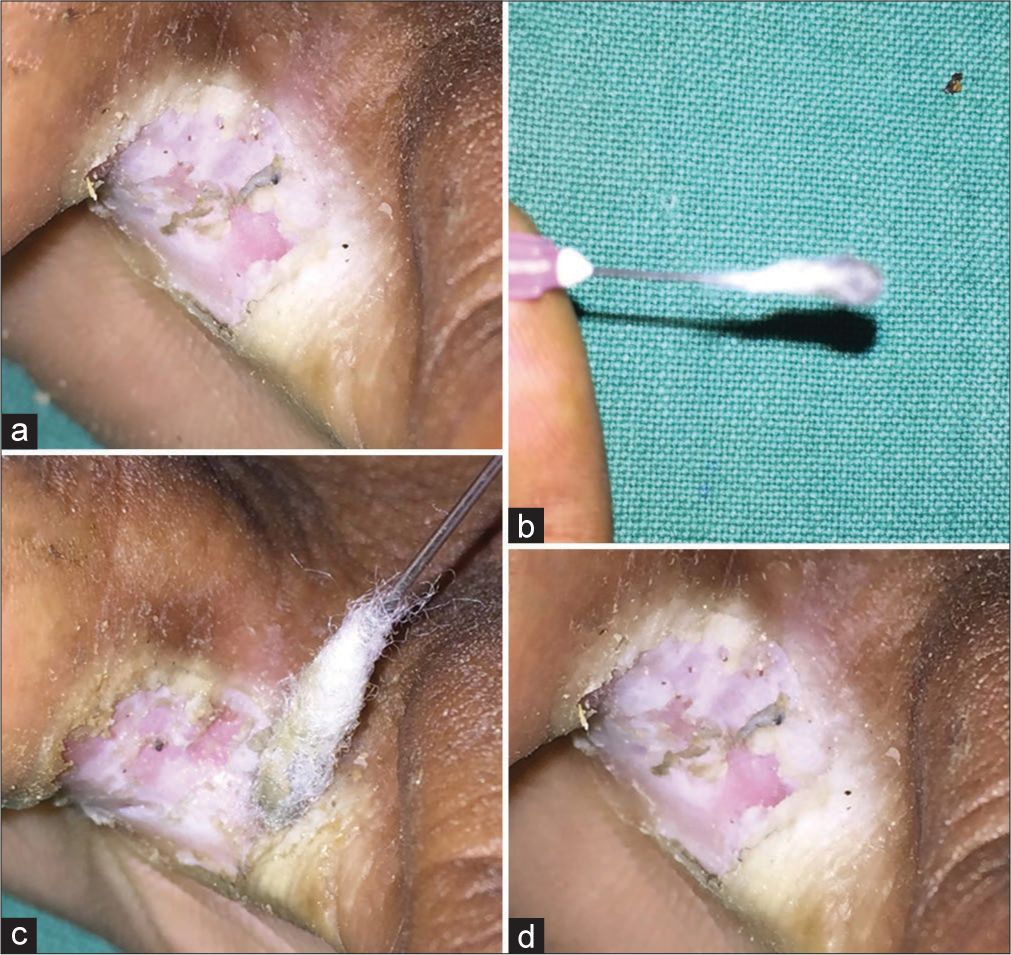Translate this page into:
Therapeutic pearl: A simple cost-effective treatment for chronic digital intertrigo of toes
*Corresponding author: Muhammed Mukhtar, Mukhtar Skin Centre, Katihar Medical College Road, Katihar, Bihar, India. drmmukhtar20@gmail.com
-
Accepted: ,
How to cite this article: Mukhtar M, Mukhtar N. Therapeutic pearl: A simple cost-effective treatment for chronic digital intertrigo of toes. J Cutan Aesthet Surg. 2024;17:256-8. doi: 10.4103/JCAS.JCAS_127_21
Abstract
Chronic intertrigo of toe-web space is a recalcitrant problem which is often associated with multi-organism infections. For this, a number of topical therapies with preventative measures are used, but many of them are cumbersome and not very effective. Cryotherapy is a good option for treating the toe intertrigo, but its availability is a major concern. Here as an alternative to cryotherapy, trichloroacetic acid (TCA) cautery and Sodium hypochlorite (NaOCl) (a broad spectrum anti-infective agent) solution is advocated as a simple, feasible, and cost-effective treatment of chronic inter digital intertrigo.
Keywords
Chemical cautery
Diabetes
Intertrigo
Shoes
NaOCl
Toe web
TCA
Water worker
PROBLEM STATEMENT
Chronic interdigital intertrigo (CII) is one of the commonest problems of toe web which is characterized by erythema, erosions, oozing, fissures, maceration, and crusting associated with itching, burning, and pain. This is more common in the third and fourth interdigital web of toe due to friction, occlusion, and moisture in diabetic, obese, shoes wearers, and water workers. CII is a recurrent infection of Candida and often associated with secondary bacterial, fungal, and viral infections.1 The chronicity of intertrigo results in local hyperkeratosis and soft corn formation, which in turn diminish the efficacy of topical antifungal and antibacterial medication. There are various modalities of treatment. However, most of them are cumbersome and not very effective.2 Cryotherapy is a good option for treating the intertrigo, but its availability is a major concern.3
RECOMMENDED SOLUTION
Five patients (3 male and 2 female in the age range of 23–42 years with chronic intertrigo of toe web for 6 months to 2 years without comorbidity) were treated with trichloroacetic acid (TCA) cautery and topical application of sodium hypochlorite solution without any other topical and oral medications. In four patients, TCA (100%) was applied in the toe web in their first visits with a cotton bud till frosting of the lesions occurs [Figure 1a-d]. After TCA cautery, 0.1% sodium hypochlorite (NaOCl) (after procuring it from its 10% stock solution in tap water) was advised to apply thrice a day for 6 weeks. In one out of five patients, the CII was treated first with topical application of sodium hypochlorite for 6 weeks, and then the remaining hyperkeratotic lesion was cauterized with TCA [Figure 2a-d]. The patients were followed up at every 2-week interval for 6 weeks. The patients are allowed to do their routine work. In each visit, the treatment response was assessed. There was acute transient pain, edema, and erythema after the cautery. There is crust formation after 7–10 days and lesions healed in about 4 weeks. TCA (hydrophilic, protein-precipitating agent) damages the keratin and epidermal barrier. It penetrates up to papillary dermis and is good for cautery up to medium depth of skin. On application of TCA, it causes burning and stinging pain due to nerve endings in the upper dermis and gives a caution to limit the cauterization. The cauterized lesion gets healed within 4 weeks,4 which is faster without systemic toxicity in comparison to phenol (hydrophilic, lipophilic, and proteolytic, anesthetic agent). TCA may damage infected cells and micro-organisms along with Candida spp. In addition to this, sodium hypochlorite solution (a broad spectrum anti-infective/antiseptic agent that works against bacteria, Candida, fungi, and viruses) is routinely used for disinfection of clinics. This solution has been well used in the treatment of chronic and severe atopic dermatitis for controlling Staphylococcus aureus of the skin surface. After seeing the chronicity and recurrence of intertrigo of toe (due to multiple causative microorganisms and emergence of their resistance), we selected sodium hypochlorite solution (on dilution release of nascent oxygen and chlorine) in treating the chronic infective lesion of toe web. Thus TCA chemical cautery and NaOCl solution in combination could be a potentially effective, safe, easily available, and cost-effective therapeutic option for treating recalcitrant CII of toe web. Larger multicenter studies are required to substantiate the effectiveness of this modality of treatment in chronic intertrigo of toes.

- (a-d) The toe web is cauterized with trichloroacetic acid (TCA) first and then put on sodium hypochlorite (NaOCl) solution.

- (a-d) Chronic intertrigo is treated with sodium hypochlorite (NaOCl) solution first for 6 weeks and then the residual hyperkeratosis was cauterized with trichloroacetic acid (TCA).
Authors’ contributions
All the authors contributed to the research study. Muhammed Mukhtar: Concepts, Design, Definition of intellectual content, Literature search, Manuscript preparation, Manuscript Editing, and Manuscript review. Nadia Mukhtar: Concepts, Design, Definition of intellectual content, Literature search, Manuscript preparation, Manuscript Editing, and Manuscript review.
Declaration of patient consent
The authors certify that they have obtained all appropriate patient consent forms. In the form the patient(s) has/have given his/her/their consent for his/her/their images and other clinical information to be reported in the journal. The patients understand that their names and initials will not be published and due efforts will be made to conceal their identity, but anonymity cannot be guaranteed.
Conflicts of interest
There are no conflicts of interest.
Financial support and sponsorship
Nil.
References
- Recurrent candidal intertrigo: Challenges and solutions. Clin Cosmet Investig Dermatol. 2018;11:175-85.
- [CrossRef] [PubMed] [Google Scholar]
- Liquid nitrogen cryotherapy for chronic recalcitrant interdigital candidiasis of toe spaces-An uncontrolled pilot study. J Am Acad Dermatol. 2018;78:1004-5.
- [CrossRef] [PubMed] [Google Scholar]
- Comparative efficacy of 10% sodium hydroxide, 88% phenol, and 90% trichloroacetic acid as chemical cauterants for partial matricectomy in the management of great toe nail onychocryptosis. J Cutan Aesthet Surg. 2020;13:314-8.
- [CrossRef] [PubMed] [Google Scholar]






